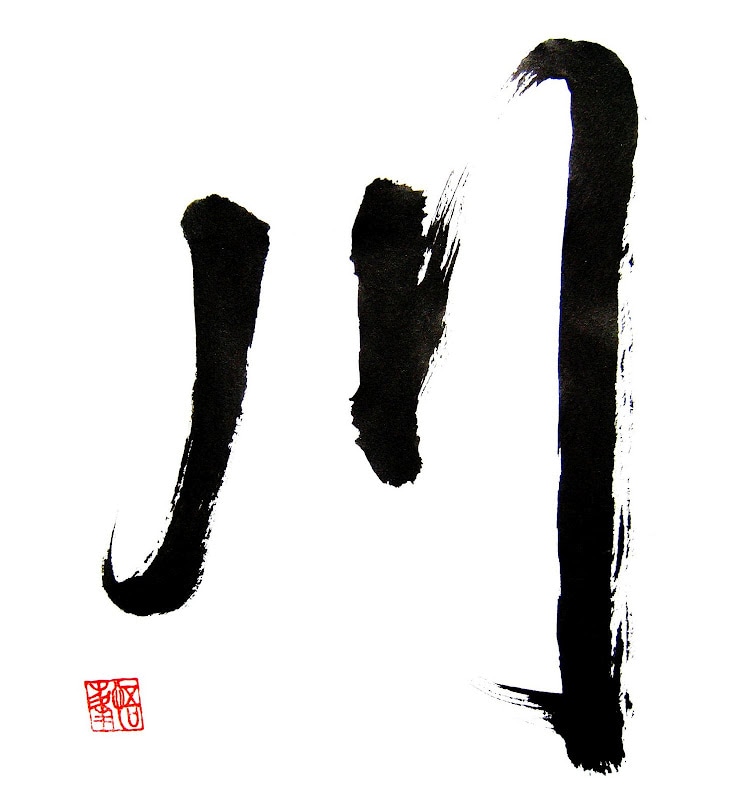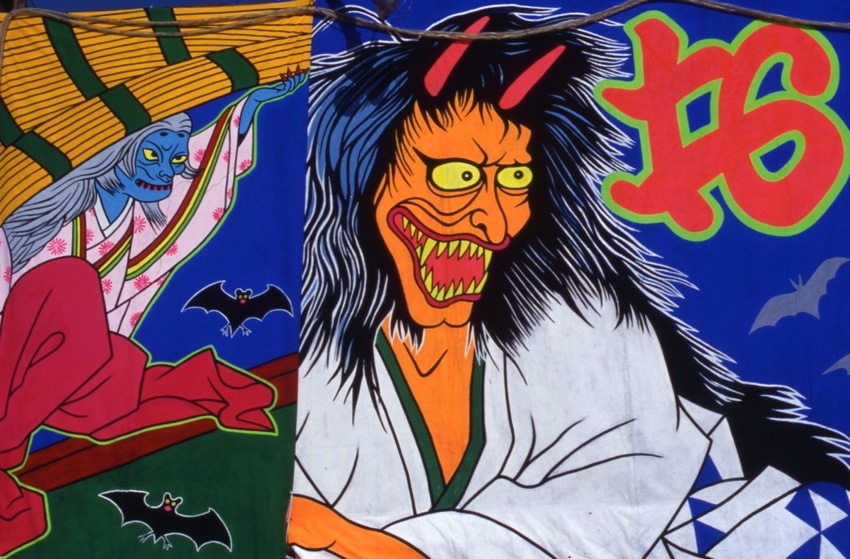|
Last night I had a dream I was trapped inside a castle besieged by peasants. They were carrying pitchforks and chanting, ‘Down with the King, down with the King!’. Since I live in a house with a kitchen sink view of a 500-year-old samurai castle, this was a completely plausible dream scenario. Only it wasn’t a dream. A rowdy mob really was below my window and it was chanting, ‘River clean! River clean!’ (Kawa-soji! Kawa-soji!). Across Japan whole communities are picking up their buckets, rakes, scythes, barrows and pitchforks, to clear their neighborhood rivers of debris and weed before the first rains of the wet season arrive in late June. With so much clamoring there was nothing for it but to leap from my futon, slip on my best threadbare rags, and join the march towards our mighty Semba River, the waterway which wends through the Good Hood, past the samurai castle, the bars, clubs and love hotels of FishTown before sidling under the bullet train tracks and emptying into the Seto Inland Sea. Under the direction of the Jichi-kai-cho (Hood boss) I took up my position at the floodgates. This is where the most interesting debris accumulates; not the usual flotsam like beer cans, baseballs, slippers and soccer balls—that’s for the downriver people. I mean the heavy junk. Junk with stories, like adult movie collections (owner got a girlfriend), air guns (owner’s girlfriend threw it out), electric fans (owner’s girlfriend demanded air-con) and bicycles (owner bought a motor-scooter to escape girlfriend). Regardless of who put it there, and in what state of sanity, sobriety or slovenliness they might have been at the time, all this stuff must be fished out before the wet season deluge arrives. River north, river south, all along the Semba’s banks, folk from our neighboring neighborhoods were hard at work, scything, dredging, shovelling, hauling weed and whatnot to big stinking riverside heaps. Wheelbarrows formed queues, manned by elderly women with big forearms and sensible shoes; a man sauntered by with a cigarette hanging off his lip, a pink bucket filled with brown muck in his hand and a twinkle in his eye that said 8am is never too early for a beer. He emptied his bucket and disappeared, leaving the two teetotallers to tend the muck heap. It’s not only the river that needs cleaning—the sluiceways also. These narrow drains which connect the rice paddies are important because they funnel away overflow after typhoons. They also provide easy escape routes for the garbage corner tomcats, ferrets and other pets-on-the-run, and in summer, hours of entertainment for kids who catch medaka (tiny fish) for their home aquariums and ‘science experiments’.. This year my job was to lean precariously over the deepest part of the river, where the rapid churns in a vertical motion, and use a garden rake to dislodge all the heavy crap that gets stuck. There were no airguns or adult movie collections this year, just a mountain of pongy-smelling weed which soaked me through and left me scented like river itself. Which is not to say that the our Semba is dirty. In fact, a sign of a healthy river is the presence of fireflies and this year there were many. Nights in the Good Hood were filled with the shouts and squeals of kids chasing them along the river bank from late May to mid-June. Which meant that there was a certain sadness in the river cleaning, because when you cut away the grass, you’re kicking out the fireflies. Smokin Joe Matsumoto, the old kitchen gardener who lives up my street, chimed in with his two yen on the matter. He said, ‘There used to be so many fireflies here, that when we swatted them with our hand fans it was like a shower of sparks.’ I wasn’t sure if this comment was meant to cheer me up or not. Nevertheless, the technical high school on the other side of the river has developed a Healthy River program which encourages students to breed fireflies in the school’s artesian well water system. Then, at the end of May, they are released at a nighttime open-invitation event for all the surrounding neighborhoods to enjoy. Unplugged, the Semba now runs freely. Like everything in the Good Hood, it doesn’t get done without teamwork. And though, at times, it sometimes seems futile (the river weed and junk will be back with the summer), community spirit is always stronger for it. We all now await, eyes skyward, the rainy season. http://www.mightytales.net/
0 Comments
A long time ago (250 years thereabouts), a powerful dude named Sakakibara Masamune decreed that the people of his castle town slip into something more comfortable and shimmy downtown for a good time. “Do what?” his attendants asked. “Throw a party, you monkeys! I’m outta here!” Indeed he was, off to rule another fiefdom, but not before starting a tradition that would fill the fine streets of Himeji with colourful summer kimono (ゆかた, yukata), octopus dumplings and (a little later) skyrockets and riot police for three days a year, every year thereafter. More than just a celebration of the highly functional yukata, it’s a fashion show. Women’s yukata colours are brighter, patterns livelier, and shock! horror! hems are rising. The elderly women of the Good Hood shake their heads and click their tongues at these parading young things in mini yukata; the young fellas just nod their heads and knock themselves out with their tongues. The Yukata Festival, held June 22-24 every year, also celebrates the rainy season. That’s right, it is the WETTEST time of the year (news just in: no rain forecast for June 22-24th) which doesn’t stop several hundred thousand people from choking the streets and alleys south of Himeji castle with coin to spend on cold beer, toys and tasty treats. There were once more than 800 stalls, erected and manned by a small army of itinerant carnivaleers called tekiya. The big hand of City Hall has nearly halved this number in recent years, in order to manage the heavy crowds. The effect, as always, has been like squeezing a tube of toothpaste - same crowds, smaller space. Word on the street is that the tekiya are in cohorts with the local yakuza; others say that’s an unfair image and that the stall holders are just abiding by a ‘system’ which takes a nice slice of their earnings and hands it to the mob. Let’s call it a ‘licensing fee’. The City seems OK with this as it ‘stimulates’ the local economy and frees up their rubber stamps for more pressing matters. Times have changed since I tagged along with some English teachers to my first Yukata Festival 20 years ago. Then, youth gangs flocked from all over the province to wage theatrical (and sometimes violent) running pitched battles with their rivals on the city streets. Hard to believe in peace-loving Japan? Well listen to this: watching riot police get pelted with skyrockets, drag troublemakers off to paddy wagons by their orange hair, and see the odd motor scooter get barbecued, reminded me of the Costa Rican fruit vendor riots of ‘91 (Yes, I was in Costa Rica in 1991). Cheap entertainment for the masses, poor public relations for the police, not exactly a festive family affair. That’s all gone. The police have changed their tune. They now use subterfuge and infiltration tactics, clever stuff like putting dozens of plain clothes officers into the crowds to catch troublemakers on digital camera or video. Maybe this has worked, or maybe the young punks have just gotten older, gotten married and gotten a job, because the Yukata Matsuri IS now a family affair. ‘Smokin Joe’ Matsumoto, the old kitchen gardener who lives on my street in the Good Hood, will be taking his grandchildren again this year. Those long sleeves of his faded yukata will be sure to hold a pack of cigarettes, a lighter and some coins for cotton candy. My old friend Ono-san won’t be going; she thinks it’s too crowded, too noisy, the food tasteless and too expensive. “I’m saving my yukata for the fireworks festivals,” she says. If YOU go, be sure to drop by the Ghost House at the edge of Otemae park; it has been a going concern for years, adept at taking your money and scaring the beejeezuss out of you with the screams of other teenage patrons. They say a good ghosting chills you out during a long, hot Japanese summer. Personally I’d prefer a cold beer... |
This Blog:What is the essence of a traditional Japanese neighbourhood? Writing from my home in Himeji, a castle town in western Honshu, Seaweed Salad Days distills, ferments, presents! Archives
March 2024
Categories
All
|


 RSS Feed
RSS Feed
